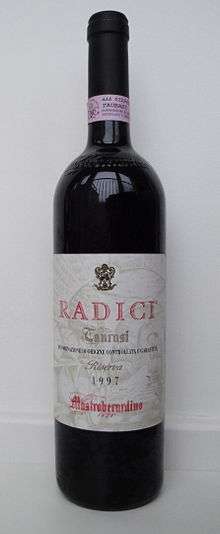Taurasi DOCG
| Taurasi | |
|---|---|
| Italian wine | |
 A bottle of Taurasi Riserva from producer Mastroberardino | |
| Wine type | DOCG |
| Decree of institution | 26 March 1970 |
| Gazzetta Ufficiale | 25 May 1970, nr. 20 |
| Yield | 100 quintals/ha |
| Maximum grape yield | 70,0% |
| Alcohol by volume of grape (natural) |
11.5% 12.0% for Taurasi riserva |
| Alcohol by volume of wine (minimum) |
12.0% 12.5% for Taurasi riserva |
| Net dry extract (minimum) | 22.0‰ |
| Origin | Province of Avellino |
| Ingredient grapes |
Aglianico: 85% – 100% Other non-aromatic red wine grapes: 0% – 15% |
Taurasi and Taurasi riserva are red, still Italian wines based principally on the Aglianico grape variety produced in the Province of Avellino in the Campania region. They were awarded Denominazione di Origine Controllata (DOC) status in 1970 and Denominazione di Origine Controllata e Garantita (DOCG) status in 1993. Produced less than 40 miles (64 km) from the other Aglianico stronghold of Aglianico del Vulture in Basilicata, the volcanic soils of the Taurasi region demonstrate the potential the Aglianico grape has to make wines on par with the Nebbiolo grape of Piedmont and Sangiovese grape of Tuscany. The popularity of the region's wine is a relatively recent phenomenon. Until the early 1990s, there was only one winery (Mastroberardino), producing wine for the export market. By the mid-2000s, there were over 293 producers in the Taurausi zone.[1]
Production zone
The vineyards may be located within the boundaries of the following communes of the Province of Avellino: Taurasi, Bonito, Castelfranci, Castelvetere sul Calore, Fontanarosa, Lapio, Luogosano, Mirabella Eclano, Montefalcione, Montemarano, Montemiletto, Paternopoli, Pietradefusi, Sant'Angelo all'Esca, San Mango sul Calore, Torre Le Nocelle and Venticano. The total area is about 420 [[km<sup>2</sup>]]s and is situated on volcanic soil.
Winemaking
The Aglianico grape thrives on vineyards at higher altitudes, around 400 to 500 meters above sea level. According to DOCG regulations, Taurasi wines must be aged a minimum of 3 years prior to release with at least 1 of those years being in wood. For wines labeled Riserva, the wines must be aged for at least 4 years.[1] The wines are made primarily from Aglianico though up to 15% of Barbera, Piedirosso and Sangiovese maybe be blended in.[2]